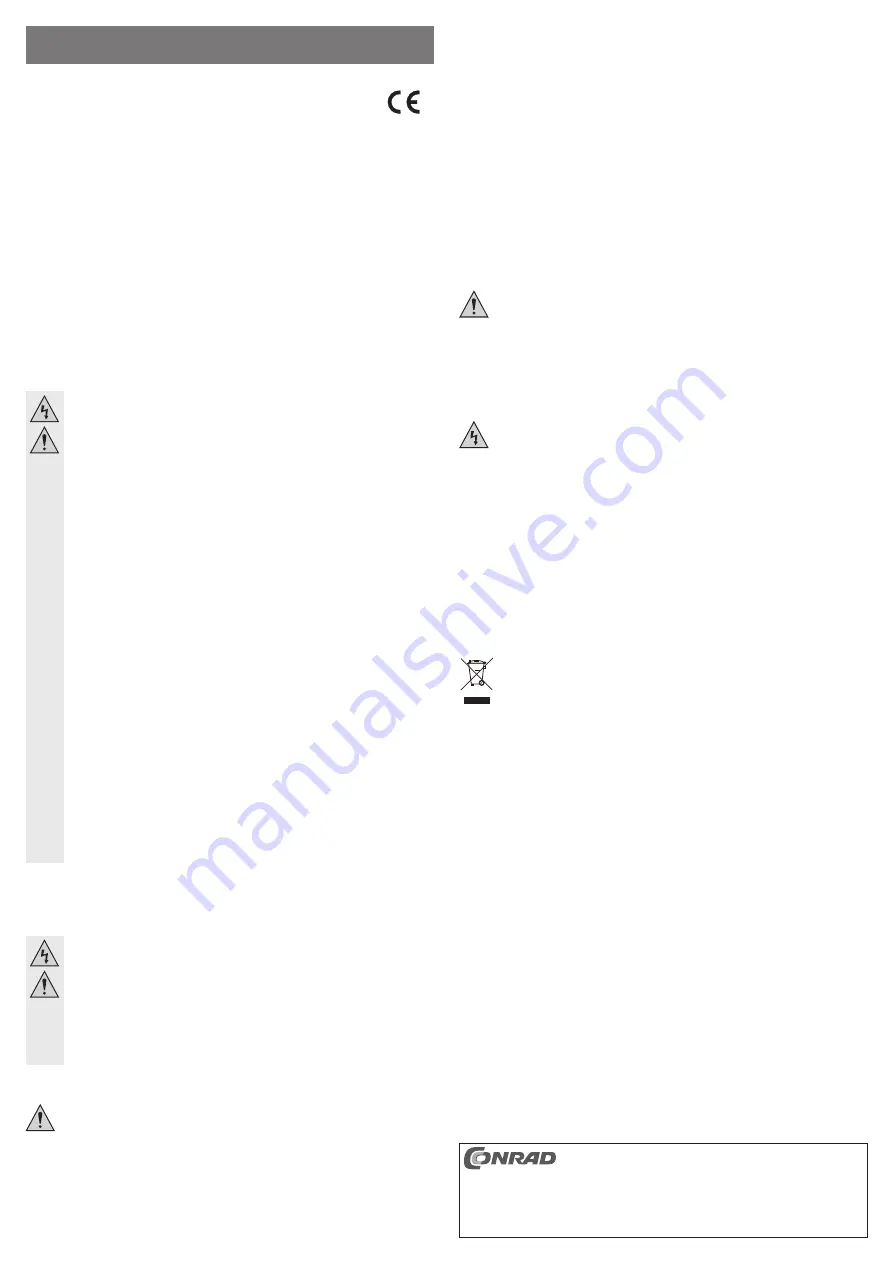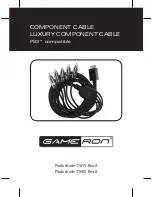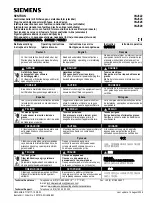
Intended use
The personal protection plug detects residual currents and interrupts the power supply of a load connected
to it when they occur (>10 mA).
The product is intended for use in dry, indoor locations.
All the safety and operating instructions in this manual must be followed carefully. These instructions not
only protect the device but also, in particular, your health. Please read the entire operating manual before
using the product.
This product complies with the applicable national and European requirements. All names of companies and
products are the trademarks of the respective owners. All rights reserved.
Package Contents
• Personal protection plug
• Operating Instructions
Safety Instructions
The warranty will be void in the event of damage caused by failure to observe these safety
instructions! We do not assume any liability for any consequential damage!
We shall not accept liability for damage to property or personal injury caused by incorrect
handling or non-compliance with the safety instructions. In such cases, the warranty will
be null and void.
• The arbitrary opening, alteration and/or modi
fi
cation of the product is not allowed for reasons
of safety and approval (CE) (except for the installation of a connecting cable described in
these operating instructions).
• The product’s construction conforms to protection class I. It should be used only with a proper
earthing contact mains socket of the public power supply.
• The product is not a toy and does not belong in the hands of children. Keep the product out of
the reach of children.
• The product may only be used in dry, enclosed spaces.
• An apparently damaged load should not be connected to the personal protection plug.
• The personal protection plug switches off the mains voltage for the connected load (bi-polar
deactivation), if there is a residual current >10 mA. Nevertheless, it is impossible to rule out
injuries due to an electric shock under unfavourable circumstances!
Consult a doctor if necessary after experiencing an electric shock!
• Use of the personal protection plug represents only a basic safety measure. Always ensure
the proper use of your electrical appliances.
•
Do not use the product any more if the casing of the personal protection plug is damaged! Do
not touch the personal protection plug, the cable or the connected appliance if it is still connect-
ed to the mains voltage! First, switch off all the poles of the mains socket to which the personal
protection plug is connected (e.g., switch off the circuit breaker and the upstream ground fault
circuit breaker). You can then remove the personal protection plug from the mains socket. Take
the product to a specialist workshop or dispose of it in an environment-friendly way.
• Never disconnect the personal protection plug out of the socket by pulling on the cable. Grasp
the personal protection plug on the housing and pull it out of the socket.
• Do not leave packaging material carelessly lying around, since it could become a dangerous
plaything for children.
• Handle the product with care; it can be damaged by impacts, blows, or accidental falls, even
from a low height.
Installation
• A suitable connecting cable (or a device with connecting cable e.g., a pump) must be installed before you
can use the personal protection plug.
Caution!
The product may be installed only by a quali
fi
ed technician (e.g. electrician) who is familiar with
the relevant regulations (e.g. VDE, German electrical wiring regulations)!
Improper work carried out at the mains endangers not only your own life but also the life of oth-
ers!
If you do not have the expertise required for the installation, do not install it yourself but entrust
the work to a quali
fi
ed electrician.
During the installation, the personal protection plug should not be connected to the mains volt-
age! There is risk of a fatal electric shock!
• Remove the two cross-head screws at the bottom edge of the personal protection plug (detach the screws
from the rear side).
Never detach the other screws of the housing. To connect a cable, remove only the lower cover!
• Remove the cover.
• Loosen the two screws of the cable relief and remove them. Note the orientation of the cable relief.
• Only a suitable
fl
exible connecting cable should be used to connect the personal protection plug; never
use a stiff installation cable.
Push the cable through the rubber protection sleeve. It should not stay loose. It should slide into the sleeve
tightly. Otherwise, protection against dust cannot be guaranteed.
Strip approx. 2 cm of the cable insulation. Then strip the insulation from the three single wires by approx.
6 - 8 mm and use suitable wire-end sleeves.
• The screw terminals are marked separately (N, L, grounding symbol). Insert the 3 coloured single wires
into the associated screw terminals (yellow/green wire = screw terminal with grounding symbol, blue wire
= screw terminal N, brown wire = screw terminal L), and tighten them.
• Place the cable relief in the correct orientation and tighten its 2 screws. Do not use force, as otherwise the
screw threads in the housing or the cable relief can be damaged. The screws should not be left too loose,
either; the cable relief should
fi
x the cable tightly.
• Close the housing, replace the cover and tighten the screws.
Getting Started
The tripping of the personal protection plug is to be checked before each start-up.
• Plug the personal protection plug properly into a ground contact mains socket.
• Press the “TEST” button of the personal protection plug; it must trip with an audible sound. The control light
goes out.
• Press the “RESET” button of the personal protection plug (a second time if the control light does not light
up). It is now ready for operation; the control light is activated.
• Start the appliance connected to the personal protection plug.
Do not operate the device again if the personal protection plug trips on starting the device con-
nected to it!
Then check the device for possible damage; take it to a specialist workshop in case of doubt or
get it examined by an electrician.
• To stop the device, just switch it off (provided it has its own power switch) and disconnect the personal
protection plug from the mains; pull it out of the mains socket.
Maintenance and Care
The product is maintenance free; never open it or dismantle it (except while performing the jobs described in
these operating instructions for installing the connecting cable).
Prior to cleaning the device, pull the plug out of the mains outlet. Clean the outer side with a dry, clean, soft
cloth. Never use aggressive cleaning agents or chemical solutions since these might damage the surface of
the casing or impair the operation.
Disposal
Electronic and electronic devices must not be disposed of in the domestic waste.
Dispose of the product at the end of its serviceable life according to the relevant legal provisions
and regulations (e.g. return it to a special recycling facility of your town).
Features and technical data
Operating voltage ........................220 - 240 V/AC, 50 Hz
Total power rating ........................Max. 3600 W
Protection class ...........................IP40
Place of operation ........................dry, indoor rooms
Nominal residual current ..............10 mA
Deactivation time .........................<30 ms
Ambient temperature ...................-25 °C to +40 °C
O P E R A T I N G I N S T R U C T I O N S www.conrad.com
Personal protection plug
Item no. 55 29 21
Version 11/12
These operating instructions are a publication by Conrad Electronic SE, Klaus-Conrad-Str. 1,
D-92240 Hirschau (www.conrad.com).
All rights including translation reserved. Reproduction by any method, e.g. photocopy, micro
fi
lming,
or the capture in electronic data processing systems require the prior written approval by the editor.
Reprinting, also in part, is prohibited.
These operating instructions represent the technical status at the time of printing. Changes in
technology and equipment reserved.
© Copyright 2012 by Conrad Electronic SE.






















